See Ceres, the Harvest Moon, and Bright Planets for Evening, Venus Kisses Mercury at Sunset, and Nice Neptune Viewing!
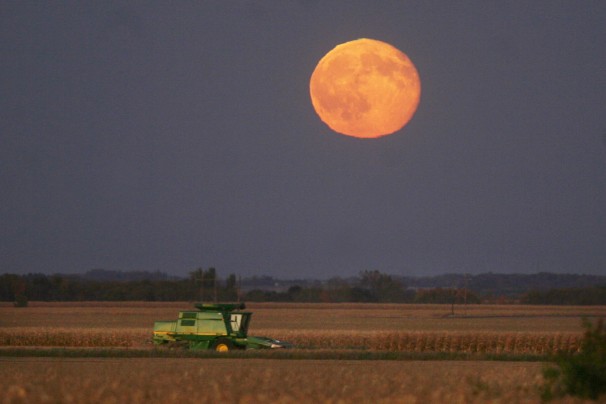
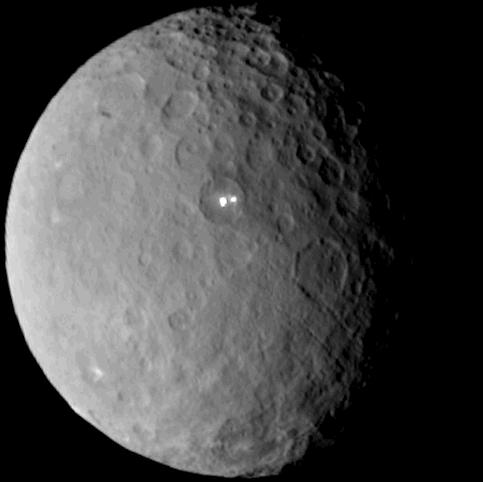
Hello, Late Summer Stargazers!
Here are your Astronomy Skylights for the week of September 8th, 2019 by Chris Vaughan. Feel free to pass this along to your friends and send me your comments, questions, and suggested topics. I repost these emails with photos at http://astrogeo.ca/skylights/ where the old editions are archived. You can also follow me on Twitter as @astrogeoguy! Unless otherwise noted, all times are Eastern Time. Please click this MailChimp link to subscribe to these emails.
I can bring my Digital Starlab inflatable planetarium to your school or other daytime or evening event. Contact me through AstroGeo.ca, and we’ll tour the Universe together!
The Moon and Planets
We’re far from finished with the moon! This week, Luna will remain in the evening sky worldwide while it waxes towards full on the coming weekend. Thankfully, our views of the bright planets don’t suffer from bright moonlight, and there’s plenty to see. Distant Neptune is at peak visibility for 2019. For early risers, the bright stars of the winter constellations gleam during the pre-dawn hours. Read on for your Skylights!
The moon will spend most of this week exhibiting a waxing gibbous phase. The word “gibbous” means “more than half illuminated” – the range of shapes between a semi-circle and a full circle. It comes from the Latin word for “hump”.
During this part of the moon’s monthly cycle, it rises in late afternoon, shines in the southern sky after dusk, and sets in the hours after midnight. Like last week, evenings between the first quarter and full phases are great for viewing the moon in binoculars and backyard telescopes. The topography along the terminator – the pole-to-pole line that divides the lit and dark hemispheres – is being lit by low-angled sunlight which produces breathtaking vistas of bright mountain peaks and crater rims, and the deep black shadows they cast. And new zones are highlighted every night.
Tonight (Sunday), the moon will sit a palm’s width to the left (celestial east) of medium-bright, yellow-tinted Saturn. You can use the moon to find Saturn before the sky is fully dark. The moon and Saturn will both fit within the field of view of binoculars. If you watch the pair over several hours, starting at dusk, you will see the moon’s orbit carry it farther from the planet. The motion of the sky due to Earth’s rotation will also lift the moon higher than Saturn before they set in the west at about 2 am local time.
From Monday to Friday, the moon will pass through the dim constellations of Capricornus (the Sea-Goat) and then Aquarius (the Water-Bearer). But its increasing brightness will all but overwhelm their stars. On the weekend, the moon will pass below dim Pisces (the Fishes). (The moon spends nearly all of the time within the zodiac constellations.)

The September full moon, traditionally known as the “Corn Moon” and “Barley Moon ”, will occur after midnight on Friday. This one always shines in or near the stars of Aquarius and Pisces. Full moons always rise around sunset and set around sunrise. Because this is the closest full moon to the autumnal equinox in 2019, it is also the Harvest Moon. On the evenings around its full phase, the moon usually rises about 50 minutes later on each consecutive night. But the shallowly sloping evening ecliptic around the equinox causes Harvest Moons to rise at almost the same time each night – only delayed by as little as 10 minutes, depending on your latitude.
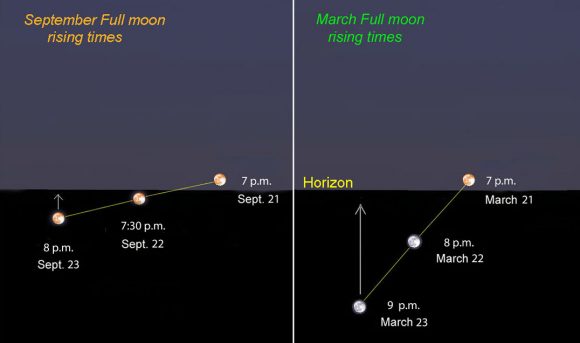
This phenomenon traditionally allowed farmers to work into the evening under bright moonlight – hence the name. It also means that if you arrive home from work or walk the dog at the same time every evening, you might notice the “full” moon for several days in a row. The effect is stronger the farther from the equator you live. The moon behaves the same way in the southern Hemisphere – but six months later, at its own autumnal equinox. By the way – this full moon will occur only 14 hours after apogee, the moon’s farthest point from Earth. As a result, it could be considered a Punymoon (the opposite of a Supermoon). It’ll appear slightly less large and bright than an average full moon.
The speedy inner planets Mercury and Venus are both shifting steadily away from the sun in their orbits. Mercury starts this week much closer to the sun than Venus, but its faster orbital motion will cause it to overtake and then pass brighter Venus this Friday. Look for the pair of planets very low in the western sky right after sunset. The planets will be less than half a finger’s width apart. (20 arc-minutes, or two-thirds of the full moon’s diameter, to be more precise.) Venus will be higher than (to the celestial north of) Mercury until Sunday, after which time Mercury will be higher and on Venus’ left. The best time to look will be at about 7:40 pm local time. (Ensure that the sun has completely disappeared below the horizon before hunting for them in binoculars.) Observers that live closer to the equator will have an easier time seeing them.
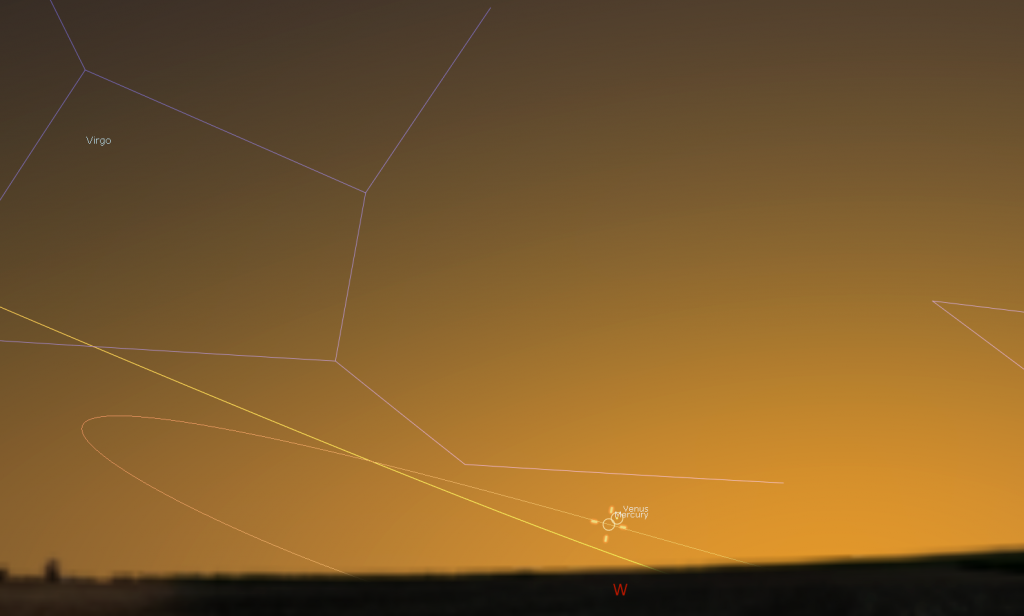
Mars will continue to be hidden in the glare of the sun until next month, when it will join the eastern pre-dawn sky.
As the sky begins to darken this week, look for the giant planet Jupiter sitting less than a third of the way up the southwestern sky. Hour by hour, Jupiter will sink lower – then set in the west by about 11:30 pm local time. Jupiter is spending the rest of this year between Ophiuchus (the Serpent-Bearer) and Scorpius (the Scorpion). Normally a planet becomes harder to see when it reaches the southwestern evening sky. But the earlier sunsets and the planet’s intense brightness will keep it in view for some time to come.
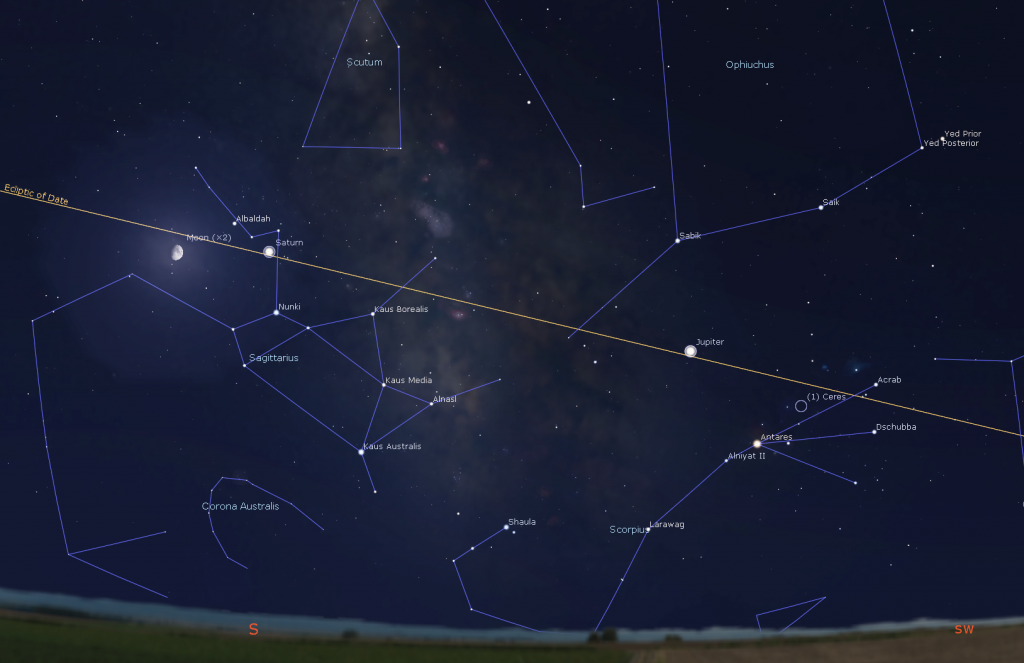
On a typical night, even a backyard telescope will show you Jupiter’s two main equatorial stripes and its four Galilean moons – Io, Europa, Callisto, and Ganymede looking like small white dots arranged in a rough line flanking the planet. If you see fewer than four dots, then some of them are in front of Jupiter, or hidden behind it. Good binoculars will show the moons, too!
Due to Jupiter’s rapid 10-hour rotation period, the Great Red Spot (or GRS) is only observable from Earth every 2nd or 3rd night, and only during a predictable three-hour window. The GRS will be easiest to see using a medium-sized, or larger, aperture telescope on an evening of good seeing (steady air). If you’d like to see the Great Red Spot in your telescope, it will be crossing the planet on Monday evening from dusk to 11:30 pm EDT, on Thursday from dusk to 9:30 pm EDT, and on Saturday from dusk until 10:30 pm EDT.
Yellow-tinted Saturn is prominent in the southern evening sky, too – but it is much less bright than Jupiter. The ringed planet will be visible from dusk until about 1:30 am local time. Saturn’s position in the sky is just to the upper left (or celestial east) of the stars that form the teapot-shaped constellation of Sagittarius (the Archer). To find Saturn, look about 3 fist diameters to the left (celestial east) of Jupiter. The Milky Way is between them. As I noted above, use the moon’s position near Saturn on Sunday night to identify the planet, then find it again after the moon has moved away.
Dust off your telescope! Once the sky is dark, even a small telescope will show Saturn’s rings and several of its brighter moons, especially Titan! Because Saturn’s axis of rotation is tipped about 27° from vertical (a bit more than Earth’s axis), we can see the top surface of its rings, and its moons can arrange themselves above, below, or to either side of the planet. During this week, Titan will migrate counter-clockwise around Saturn, moving from the lower right of Saturn tonight (Sunday) to above the planet next Sunday. (Remember that your telescope will flip the view around.)
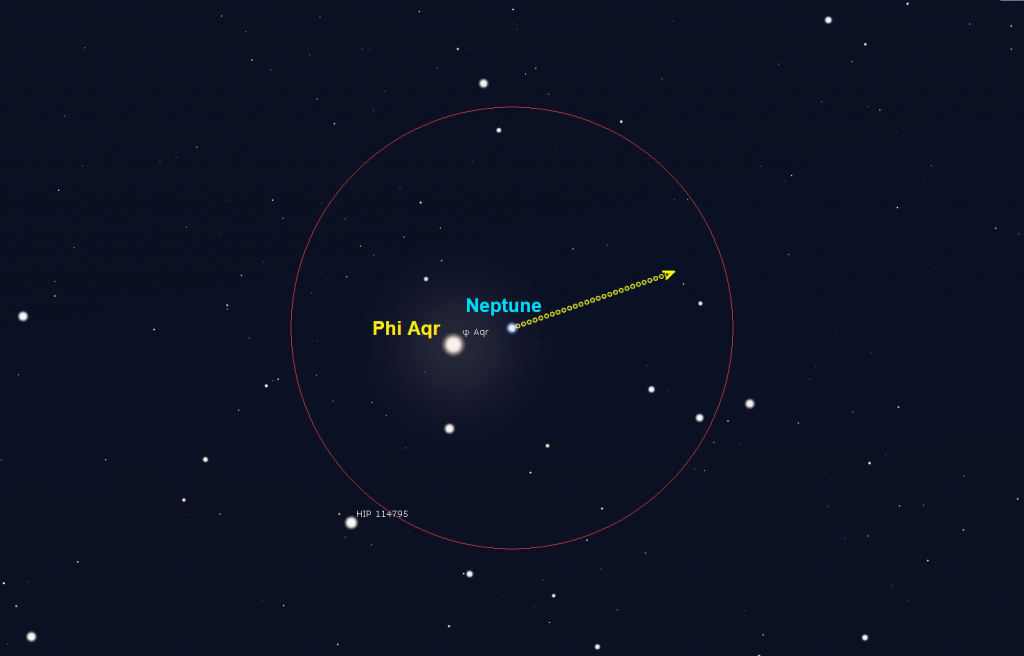
On Tuesday, September 10, Earth’s orbital motion will position us so that tiny, blue Neptune will be directly opposite the sun in the sky. At opposition, Neptune will be closest to Earth for the year, appear slightly brighter and larger in telescopes, and remain visible from dusk to dawn. The dim, magnitude 7.8, blue planet will be located among the stars of eastern Aquarius, just a small distance to the right (celestial west) of a medium-bright star named Phi (φ) Aquarii. Both blue Neptune and that golden-tinted star will appear together in the field of view of a backyard telescope at medium power. After this week, the distance between the two objects will steadily increase due to Neptune’s westward retrograde orbital motion. I’ll post a diagram of Neptune’s position compared to that star here.
Blue-green Uranus will be rising in the east just before 9:30 pm local time this week; and it will remain visible all night long. Uranus is sitting below (celestial south of) the stars of Aries (the Ram) and is just a palm’s width above the head of Cetus (the Whale). At magnitude 5.8, Uranus is actually bright enough to see in binoculars and small telescopes, under dark skies – and it really does look light blue! You can use the three modest stars that form the top of the head of the whale (or sea-monster in some tales) to locate Uranus for months to come – that’s because that distant planet moves so slowly in its orbit. To help you find it, I posted a detailed star chart here.
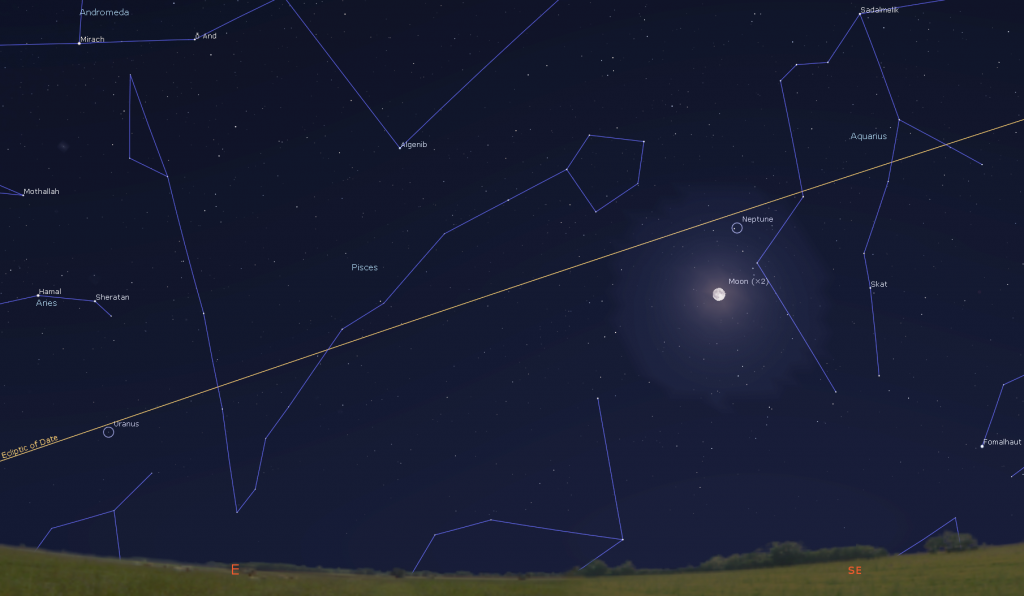
If you’ve ever wanted to see an asteroid, Ceres, the first one discovered, is conveniently placed in the evening sky this month. Ceres’ name is related to the word “cereal”, as both arise from the Greek Goddess of Agriculture. Originally considered the missing planet between Mars and Jupiter after its discovery by Giuseppe Piazzi (in 1801), Ceres was downgraded to an asteroid soon afterwards, and then upgraded to Dwarf Planet status in 2006 – at the same time Pluto was demoted to join the same family as Ceres.
This week, Ceres will be slowly moving eastward above the bright, reddish star Antares in Scorpius. With a visual magnitude of 8.9, Ceres will be readily seen in backyard telescopes. Binoculars will work, too – once the bright moon leaves the scene. Ceres is located about degrees (4 finger widths) to the upper right (or celestial north) of Antares. On Thursday night, it will pass very close above a double star named p Ophiuchi. That star is visible to unaided eyes.
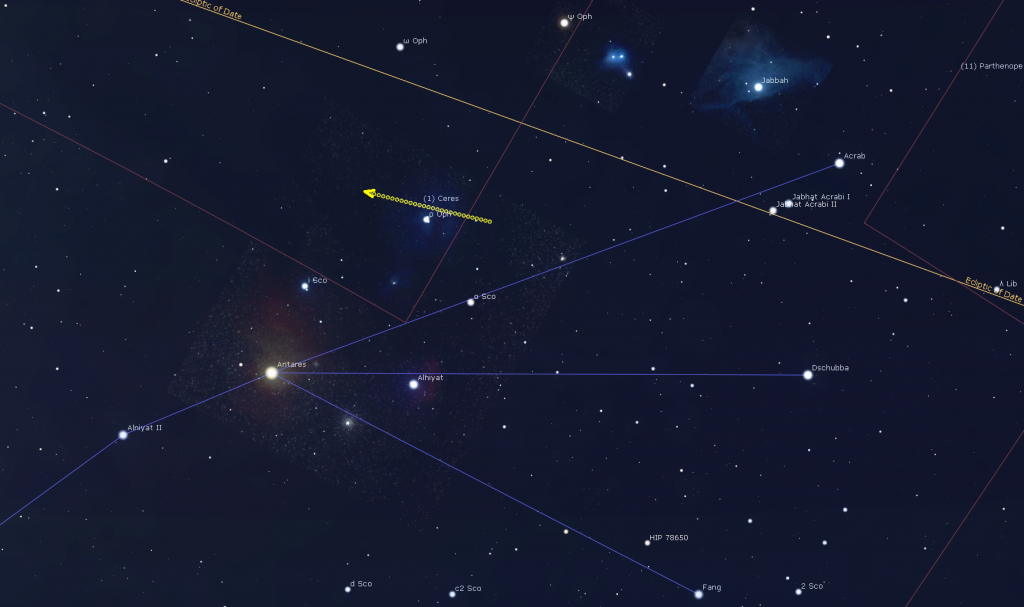
The Northern Crown is in the West
If you missed last week’s tour of Corona Borealis (the Northern Crown), I posted it here, with a sky chart that shows where these stars are located.
Public Astro-Themed Events
Every Monday evening, York University’s Allan I. Carswell Observatory runs an online star party – broadcasting views from four telescopes/cameras, answering viewer questions, and taking requests! Details are here. On Wednesday nights they offer free public viewing through their rooftop telescopes. If it’s cloudy, the astronomers give tours and presentations. Details are here.
At 7:30 pm on Wednesday, September 11, the RASC Toronto Centre will hold their free monthly Recreational Astronomy Night Meeting at the Ontario Science Centre, and the public are welcome. Talks include The Sky This Month, an equipment review, and more. These meetings are also streamed live on RASC-TC’s YouTube channel. Check here for details. Parking is free.
If the skies are clear on Saturday night, September 14 from 7:30 to 10:30 pm, the Dunlap Institute at U of T will host a huge Planet Gazing Party on the back campus fields. I’ll be there with my big telescope. This all-ages, drop-in event is free, but arrive early. Detailsand a map are found here.
From Tuesday through Sunday this week, the Bentway, located near Fort York, will present a celebration of the Harvest Moon. There will be displays, music, and presentations by scientists and artists. All events are free and open to everyone. Details and a schedule of events is here.
Please note: Due to some filming permits at DDO, some of our events in September have been moved. Here’s the updated information…
The next RASC-hosted Night at the David Dunlap Observatory will be on Saturday, September 21. There will be sky tours in the Skylab planetarium room, space crafts, a tour of the giant 74” telescope, and viewing through the 74” and lawn telescopes (weather permitting). The doors will open at 8:30 pm for a 9 pm start. Attendance is by tickets only, available here. If you are a RASC Toronto Centre member and wish to help us at DDO in the future, please fill out the volunteer form here. And to join RASC Toronto Centre, visit this page.
This Fall and Winter, spend a Sunday afternoon in the other dome at the David Dunlap Observatory! On Sunday afternoon, October 20, from noon to 4 pm, join me in my Starlab Digital Planetarium for an interactive journey through the Universe at DDO. We’ll tour the night sky and see close-up views of galaxies, nebulas, and star clusters, view our Solar System’s planets and alien exo-planets, land on the moon, Mars – and the Sun, travel home to Earth from the edge of the Universe, hear indigenous starlore, and watch immersive fulldome movies! Ask me your burning questions, and see the answers in a planetarium setting – or sit back and soak it all in. Sessions run continuously between noon and 4 pm. Ticket-holders may arrive any time during the program. The program is suitable for ages 3 and older, and the Starlab planetarium is wheelchair accessible. For tickets, please use this link.
Keep looking up, and enjoy the sky when you do. I love questions and requests – so, send me some!